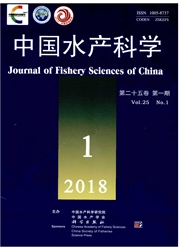

 中文摘要:
中文摘要:
本研究旨在建立虾夷扇贝的动态能量收支(Dynamic Energy Budget,DEB)数值模型,为进一步构建北方海域虾夷扇贝养殖容量评估模型奠定基础。根据DEB理论,以水温和叶绿素浓度作为强制函数,基于现场及室内实验收集DEB模型参数,针对桑沟湾养殖环境和虾夷扇贝生长的数据,利用STELLA软件构建了虾夷扇贝的DEB模型,以长海县养殖环境和1龄、2龄、3龄虾夷扇贝生长的数据对模型进行验证。模型的模拟结果显示:(1)构建的DEB模型能够很好地模拟虾夷扇贝软体部干重的生长,反映了不同时间的能量分配情况;(2)在桑沟湾,6月1日至9月25日期间水温的限制性强于食物限制;在长海海域,9月15日至次年的6月20日期间食物的限制性强于水温的限制,由此推断,长海海域虾夷扇贝的养殖密度过大,可能超出了海域的养殖容量。另外,敏感性分析结果显示,能量分配系数k以及食物摄食能力参数–最大体表面积吸收率PAM、半饱和常数Xk,对虾夷扇贝生长模拟结果有着较大的影响,例如,PAM提高10%,生长模拟结果可增加13%。因此,这些敏感性较大的参数需要通过室内实验或者现场实验准确测定,谨慎赋值。
 英文摘要:
英文摘要:
The dynamic energy budget (DEB) theory is a mechanistic theory of metabolism that captures the flows of energy and matter throughout the entire lifecYcle of an organism. A DEB model of an individual organism describes the rates at which the organism assimilates and utilizes energy for maintenance, growth and reproduction, as functions of the state of the organism and its environment. The purpose of the present paper is to setup a DEB model for Japanese scallop Patinopecten yessoensis, the main mariculture species of northern China, in order to understand the energy distribution characteristics of the scallop and to analysis the influence of temperature and food availability on its growth and reproduction. The model depends on seawater temperature and food density (chlorophyll-a concentration), as forcing variables. The key DEB parameter values for the scallop were calculated based on previous experiments in our laboratory. We calibrated and validated with stage data for mariculture efforts in Sungo Bay from May to December 2013, and for small-, middle- and large-sized scallop from Changhai, China, from August 2007 to July 2008. The DEB model developed here showed good growth simulations and pro- vided an extensive description of the energetic allocation ofP. yessoensis throughout its growth span. Meanwhile, it was demonstrated that, in summer, seawater temperature was the main limiting factor for scallop growth. Especially in Sungo Bay, at days 45-125 (nearly 85 days' duration), the value of T-dependence was very low, as scallop growth was limited by water temperature, and the scallop almost ceased to grow at this stage. In Changhai, at days 40-320, food limitation was stronger than the temperature restriction, which proved that mariculture densities might become overloaded. The results of the sensitivity analysis showed the model was relatively sensitive to changes in K, PAM and Xk. For example, as PAM increased by 10%, the growth of the scallop could be increased by 13%. Therefore, the sensitivity
 同期刊论文项目
同期刊论文项目
 同项目期刊论文
同项目期刊论文
 期刊信息
期刊信息
